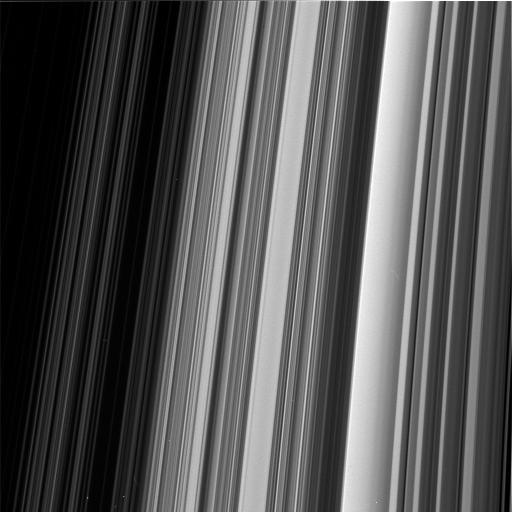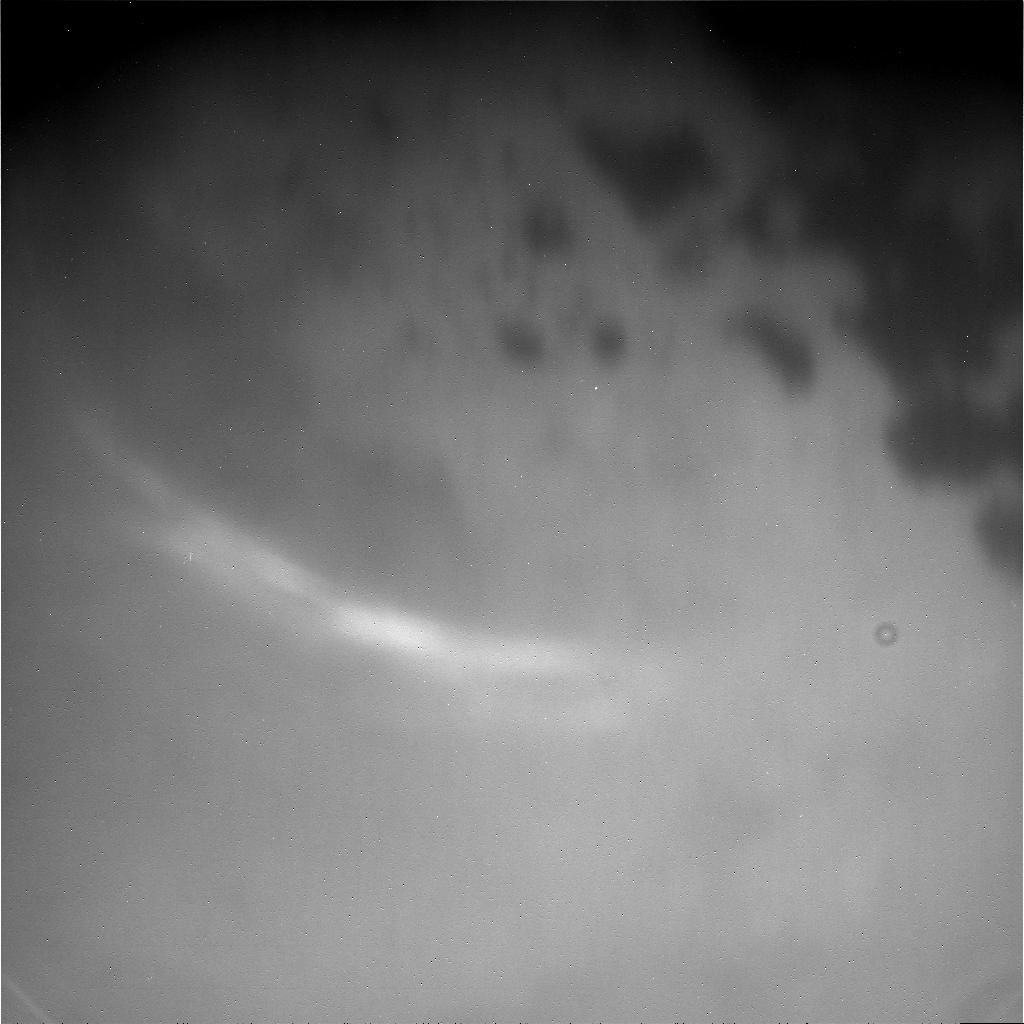
As Cassini’s “Grand Finale” journey continues, the spacecraft has completed its eighth dive past the innermost rings of Saturn (known as a ring crossing), and there are now just under 100 days left until it plunges into the giant planet’s atmosphere, never to come back. Although time may be running out, Cassini continues to devour every drop of science data that it can, which builds upon other data that has transformed our view of the Saturnian system – a complex array of worlds like a miniature Solar System. This includes, of course, more fantastic images of Saturn and its rings and moons. The detail seen in the rings is nothing short of staggering.
The latest ring crossing is part of the eighth orbit during the Grand Finale phase of the mission, which consists of 22 orbits in total. Each orbit takes Cassini directly “through” the rings, passing through the gap between the innermost rings and the planet itself. This is the first time that any spacecraft has ever done this, providing views never seen before. The final orbit however will end with Cassini plunging into Saturn’s atmosphere, where it will meet its fiery fate. This is done on purpose – the spacecraft will have run out of fuel by then and mission scientists do not want it possibly colliding with any of Saturn’s moons where it could potentially contaminate them with any earthly microbes which may still be alive onboard. So the option was chosen to let Cassini burn up in the atmosphere – a spectacular end to a spectacular mission.

As outlined on the website, the highlights of the eighth orbit and ring dive include:
- During this orbit, Cassini’s Radio Science Subsystem (RSS) performs the fourth of six radio occultations of Saturn’s ring system and runs a gravity experiment to study Saturn’s gravitational field in the highest possible detail. The experiment seeks to measure how spherical Saturn’s gravity field is, and to help scientists measure the mass of Saturn’s rings, a figure that is not precisely known.
- During the radio experiments, Cassini’s Cosmic Dust Analyzer (CDA) scoops up and analyzes small ring particles to help determine the age of Saturn’s rings. Interplanetary meteoroids bombard Saturn’s main rings, depositing silicates, organics, and metals in the ring particles. The more of those contaminants the CDA finds, the older Saturn’s rings probably are.
- Next Cassini’s Visible and Infrared Mapping Spectrometer (VIMS) maps Saturn’s southern hemisphere at some of the highest resolutions of the mission. The instrument looks for changes in winds, cloud structures and perhaps changes in atmospheric chemistry as the rate of atmospheric upwelling changes with seasons.
- During this orbit, Cassini gets within 2,120 miles (3,410 kilometers) of Saturn’s 1-bar level. Cassini also passes within 2,670 miles (4,300 kilometers) of the inner edge of Saturn’s D ring.
The moons of Saturn, at least 62, are some of the most complex and bizarre in the entire Solar System and NASA has also just posted a summary “tour” of them. From small to large, these moons do indeed feel like a smaller version the Solar System, presenting scientists with many surprises and discoveries. They are not just chunks of rock and ice, or dots of light in a telescope, they are worlds in their own right.
Phoebe was the first moon that Cassini flew close to, with the spacecraft passing within 1,300 miles (2,100 kilometers) on June 11, 2004. Phoebe is a small and heavily cratered body, only 130 miles (210 kilometers) wide, but it was a beautiful close-up, and only the first of many such encounters to come for Cassini.
The closest-ever flyby was of the moon Enceladus, where Cassini flew in October 2008 at only 16 miles (25 kilometers) above the surface. Enceladus id one of the most fascinating places in the entire Solar System, with huge water vapor geysers erupting at the south pole, originating from a global ocean of water beneath the outer ice crust. That salty water ocean, similar to oceans on Earth, is now one of the primary targets in the search for life elsewhere in the Solar System.




Iapetus is another weird moon, with one hemisphere as dark as charcoal and the other gleaming white. There is also an unusual mountain-like ridge which wraps almost all the way around the moon’s equator, making the moon kind of look like a walnut. The ridge may have formed when a former ring collapsed onto the surface. Some even smaller moons such as Pan and Atlas also have bizarre skirt-like equatorial ridges, thought to be built from Saturn’s ring particles.
“At least three of Saturn’s little moons have those little skirts,” said Bonnie Buratti, a senior research scientist at NASA’s Jet Propulsion Laboratory. “And we wouldn’t have known that without these flybys.”
The moon Tethys is larger and mostly covered in craters, but also has unusual long arc-shaped red streaks on its surface which so far haven’t been explained.
“The streaks look like they’re painted on,” Buratti said. “They are very, very mysterious.”


And of course there’s Titan, the largest of Saturn’s moons, and the only one in the Solar System to have a thick atmosphere. The atmosphere is mostly nitrogen, like Earth’s, with a dense methane haze. Dozens of liquid methane-ethane seas and lakes cover the surface near the north pole, and to a lesser extent at the south pole. Methane rain falls to the surface and creates rivers which feed into the seas and lakes, mimicking the hydrological cycle on Earth. Beneath the surface there is also now thought to exist a water ocean much like that on Enceladus or Jupiter’s moon Europa, but deeper down. During the third ring crossing, as well as this one, Cassini observed wispy methane clouds floating high in the atmosphere. Cassini also used Titan’s gravity to help move it into the correct orbits for the Grand Finale.
“We use the gravity of Titan to change the trajectory of the spacecraft,” said Brent Buffington, a trajectory designer for the Cassini mission.
As also recently reported, Cassini found evidence that the moon Enceladus likely tipped over in the distant past, by as much as 55 degrees. The cause is still unknown however but could have been from an impact with another large object.



“We found a chain of low areas, or basins, that trace a belt across the moon’s surface that we believe are the fossil remnants of an earlier, previous equator and poles,” said Radwan Tajeddine, a Cassini imaging team associate at Cornell University, Ithaca, New York, and lead author of the paper.
“Cassini has brought Saturn and its family of moons into our neighborhood, making them as familiar as your own backyard,” said Linda Spilker, Cassini project scientist. “With Cassini’s final heartbeat, our close personal connection to the Saturn system will be gone, but so much more remains to be discovered. We must go back!”
The next ring crossing will be on June 16. On Sept. 15, 2017, Cassini’s journey will finally end, but it has provided scientific wonders that will be studied for many years to come.
More information about the Grand Finale phase of the mission is here. All of Cassini’s raw images can be seen here on the mission website, and more information about the Cassini mission itself is available here.
Be sure to “LIKE” AmericaSpace on Facebook and follow us on Instagram & Twitter!






One wonders if both Saturn and Jupiter are, in a sense, “failed” mini solar sytems.